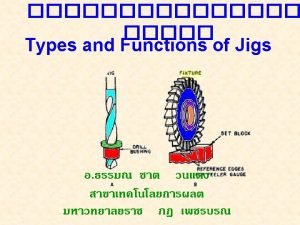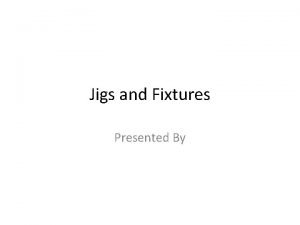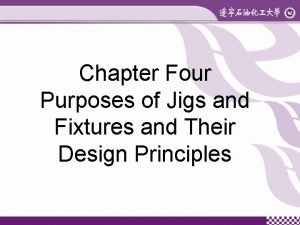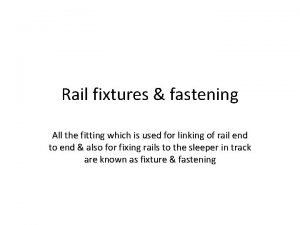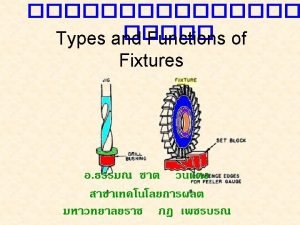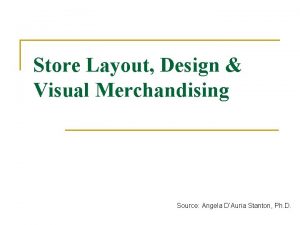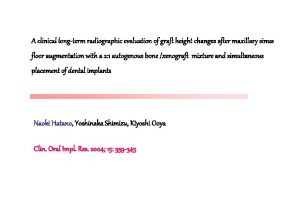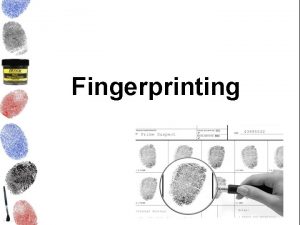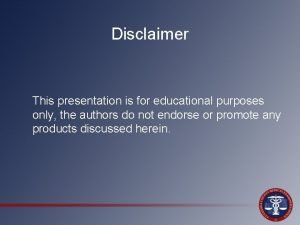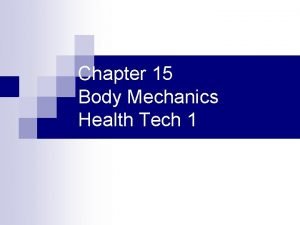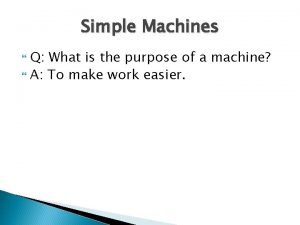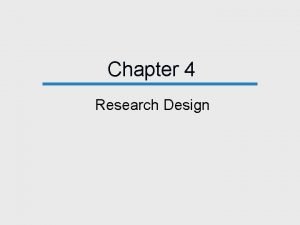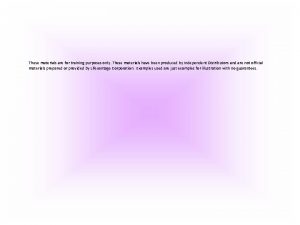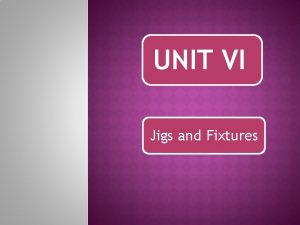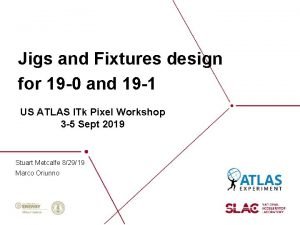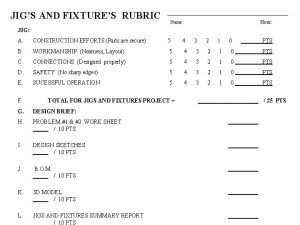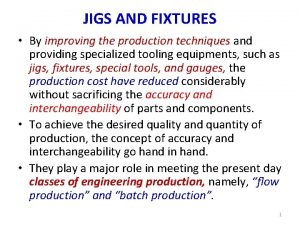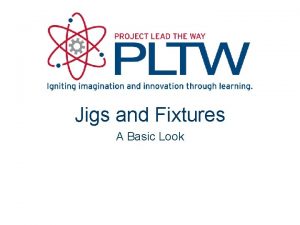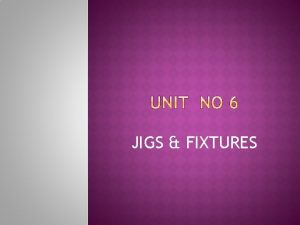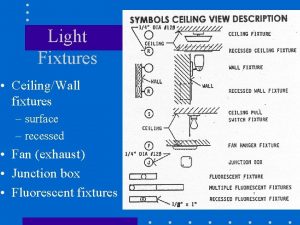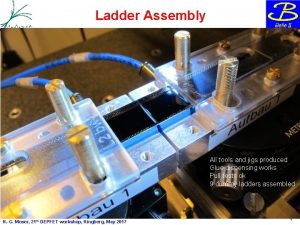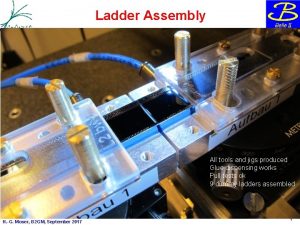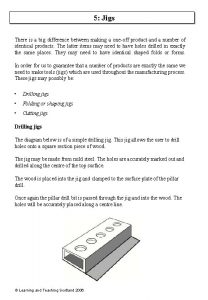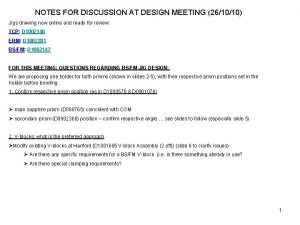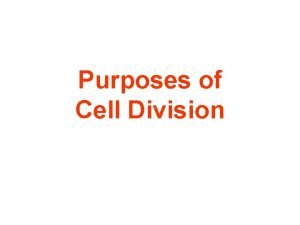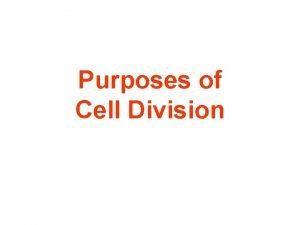Chapter Four Purposes of Jigs and Fixtures and














































- Slides: 46

Chapter Four Purposes of Jigs and Fixtures and Their Design Principles


A. introduction The accuracy achieved during a machining process depends upon the precision with which the tool and the workpiece are mounted in the machine tool along with their accurate movement. Normal work-holding devices, such as chucks and vises, are suitable for general purpose work, but when required to be used repeatedly for a large number of identical parts, the set-up and clamping time becomes unacceptable. Hence for production work involving large number of parts, it is necessary to have separate jigs and fixtures to be designed for specific application such that the set-up time is reduced to the absolute minimum that is possible.

Jigs and fixtures are the production devices that are used for the accurate production of repeated parts essentially for mass production. The required accuracy is achieved by maintaining the precise relationship between the various surfaces of the fixture and the part to be manufactured. A jig or fixture needs to provide the following functionality to be an effective production device. 1. Location 2. Clamping 3. Support 4. Resistance to cutting forces 5. Safety

B. Definition of Fixture and Jig Fixtures: being used in machine shop, are strong and rigid mechanical devices which enable easy, quick and consistently accurate locating, supporting and clamping, blanks against cutting tool(s) and result faster and accurate machining with consistent quality, functional ability and interchangeability. Jig is a fixture with an additional feature of tool guidance.

C. Purpose Of Using Fixtures And Jigs For a machining work, like drilling a through hole of given diameter eccentrically in a premachined mild steel disk as shown in Fig. 4. 1 in a conventional drilling machine without using any fixture or jig, the following elementary steps are to be sequentially followed. Fig. 4. 1 A through hole has to be drilled in a pre-machined mild steel disc.


Therefore it appears that so many operations are needed to be carried out carefully and skilfully by the machinist or operator for such a simple job. Even after that there may be inaccuracies in machining. Such tedious and time consuming manual work are eliminated or drastically reduced in mass production by automatic or special purpose machine tools. But such machine tools are quite expensive and hence are economically justified for only huge or mass production and not viable for small lot or batch production. For batch production proper design and use of simple but effective jigs and fixtures are appropriate and economically justified.

The basic purposes of developing and using suitable jigs and fixtures for batch production in machine shops are : ●to eliminate marking, punching, positioning, alignments etc. ●easy, quick and consistently accurate locating, supporting and clamping the blank in alignment of the cutting tool ● guidance to the cutting tool like drill, reamer etc. ● increase in productivity and maintain product quality consistently ● to reduce operator’s labour and skill – requirement ●to reduce measurement and its cost ●enhancing technological capacity of the machine tools ● reduction of overall machining cost and also increase in interchangeability

D. Principles And Methods Of Locating, Supporting And Clamping Blanks And Tool Guidance In Jigs And Fixtures It is already emphasized that the main functions of the jigs and fixtures are : (a) easily, quickly, firmly and consistently accurately • locating • supporting and • clamping the blank (in the jig or fixture) in respect to the cutting tool(s) (b) providing guidance to the slender cutting tools using proper bushes There and can be several methods of locating, supporting and clamping depending upon the size, shape and material of the job, cutting tool and the machining work required. But some basic principles or rules are usually followed while designing for locating, supporting and clamping of blank in fixtures.

(a) Locating, Supporting and Clamping of jobs in jigs and fixtures 1、Locating – principles and methods ●Principles or rules of locating in jigs and fixtures For accurate machining, the workpiece is to be placed and held in correct position and orientation in the fixture (or jig) which is again appropriately located and fixed with respect to the cutting tool and the machine tool. It has to be assured that the blank, once fixed or clamped, does not move at all. Any solid body may have maximum twelve degrees of freedom as indicated in Fig. 4. 2. By properly locating, supporting and clamping the blank its all degrees of freedom are to be arrested as typically shown in Fig. 4. 3.

Fig 4. 2 Possible degrees of freedom of a solid body. The three adjacent locating surfaces of the blank (workpiece) are resting against 3, 2 and 1 pins respectively, which prevent 9 degrees of freedom. The rest three degrees of freedom are arrested by three external forces usually provided directly by clamping. Some of such forces may be attained by friction.

Fig. 4. 3 Arresting all degrees of freedom of a blank in a fixture.

Some basic principles or rules need to be followed while planning for locating blanks in fixtures, such as; ● One or more surfaces (preferably machined) and / or drilled / bored hole(s) are to be taken for reference ● The reference surfaces should be significant and important feature(s) based on which most of the dimensions are laid down ● Locating should be easy, quick and accurate ● In case of locating by pin, the pins and their mounting and contact points should be strong, rigid and hard ● A minimum of three point must be used to locate a horizontal flat surface

●The locating pins should be as far apart as feasible ●Vee block and cones should be used for self-locating solid and hollow cylindrical jobs as typically shown in Fig. 4. 4 Locating by Vee block and cone.

●Sight location is applicable to first – operation location of blank with irregular surfaces produced by casting, forging etc. as indicated in Fig. 4. 5. when the bracket is first located on two edges to machine the bottom surface which will be used for subsequent locating. Fig. 4. 5 (a) Sight location and (b) location by pivoted points (equalizer)

2、General methods of locating Δ Locating blanks for machining in lathes In lathes, where the job rotates, the blanks are located by ο fitting into self centering chuck ο fitting into 4 – independent jaw chuck and dead centre ο in self – centering collets ο in between live and dead centres ο by using mandrel fitted into the head stock – spindle ο fitting in a separate fixture which is properly clamped on a driving plate which is coaxially fitted into the lathe spindle.

Δ Locating for machining in other than lathes In machine tools like drilling machine, boring machine, milling machine, planing machine, broaching machine and surface grinding machine the job remains fixed on the bed or work table of those machine tools. Fixtures are mostly used in the aforesaid machine tools and jig specially for drilling, reaming etc. for batch production. For machining in those jigs and fixtures, the blank is located in several ways which include the followings :

Locating by flat surfaces Fig. 4. 6 typically shows locating jobs by their flat surfaces using various types of flat ended pins and buttons. Fig. 4. 6 Locating by (a) flat surfaces and (b) types of pins used for that.

Locating by holes In several cases, workpieces are located by premachined holes, such as; ∗ Locat ing by two hol es as shown in Fi g. 4. 7 (a) where one of the pins has to be diamond shaped to accommodate tolerance on the distance between the holes and their diameters ∗ Locat ing by one hol e and an ext er nal pi n wh i ch pr esent s rot at ion of the blank around the inner pin as indicated in Fig. 4. 7 (b) Fig. 4. 7 Locating by holes.

∗ Locating by one hole and one Vee-block as shown in Fig. 4. 8 Locating by a pin and Vee block.

Locating on mandrel or plug Ring or disc type workpieces are conveniently located on mandrel or single plug as shown in Fig. 4. 9. However, there may be several other ways of locating depending upon the machining conditions and requirements. Fig. 4. 9 Locating by mandrel or plug.

2、Supporting – principles and methods A workpiece has to be properly placed in the jig or fixture not only for desired positioning and orientation but also on strong and rigid support such that the blank does not elastically deflect or deform under the actions of the clamping forces, cutting forces and even its own weight. Basic principles or rules to be followed while designing or planning for supporting ο supporting should be provided at least at three points ο supporting elements and system have to be enough strong and rigid to prevent deformation due to clamping and cutting forces ο unsupported span should not be large to cause sagging as indicated in fig. 4. 10

Fig. 4. 10 Deflection due to force(s) for wide gap in between supports. ο supporting should keep the blank in stable condition under the forces as indicated in fig. 4. 11 Fig. 4. 11 Stability in supporting.

ο for supporting large flat area proper recess is to be provided, as indicated in fig. 4. 12 for better and stable support. Fig. 4. 12 Recess in long span supporting. ο round or cylindrical workpieces should be supported (along with locating) on strong vee block of suitable size ο heavy workpieces with pre-machined bottom surface should be supported on wide flat areas, otherwise on flat ended strong pins or plugs.

ο if more than three pins are required for supporting large workpieces then the additional supporting pins are to be spring loaded or adjustable ο additional adjustable supporting pins need to be provided ∗ to compensate part size variation ∗ when the supporting surface is large and irregular ∗ when clamping and cutting forces are large ο ring or disc type jobs, specially requiring indexing should be supported (and located) in mandrel

• Common methods of supporting job in fixtures ο supporting on vices ο supporting on flat surfaces / blocks (fig. 4. 13 (a)) ο supporting by fixed pins (fig. 4. 13(b)) Fig. 4. 13 Supporting (a) by flat surface and (b) by pins

ο additional supporting by adjustable pins and plugs or jack screws as shown in fig. 4. 14 Fig. 4. 14 Adjustable supporting pins.

3、Clamping of workpiece in fixtures In jigs and fixtures the workpiece or blank has to be strongly and rigidly clamped against the supporting surfaces and also the locating features so that the blank does not get displaced at all under the cutting forces during machining. • While designing for clamping the following factors essentially need to be considered : ο clamping need to be strong and rigid enough to hold the blank firmly during machining ο clamping should be easy, quick and consistently adequate ο clamping should be such that it is not affected by vibration, chatter or heavy pressure ο the way of clamping and unclamping should not hinder loading and unloading the blank in the jig or fixture

ο the clamp and clamping force must not damage or deform the workpiece ο clamping operation should be very simple and quick acting when the jig or fixture is to be used more frequently and for large volume of work ο clamps, which move by slide or slip or tend to do so during applying clamping forces, should be avoided ο clamping system should comprise of less number of parts for ease of design, operation and maintenance ο the wearing parts should be hard or hardened and also be easily replaceable ο clamping force should act on heavy part(s) and against supporting and locating surfaces ο clamping force should be away from the machining thrust forces ο clamping method should be fool proof and safe ο clamping must be reliable but also inexpensive

• Various methods of clamping Clamping method and system are basically of two categories : (a) general type without much consideration on speed of clamping operations (b) quick acting types (a) General clamping methods : in Fig. • Screw operated strap clampsofascommon typically use shown 4. 15. The clamping end of the strap is pressed against a spring which enables quick unclamping Fig. 4. 15 Common strap type clamping.

• Clamping from side for unobstructed through machining (like milling, planing and broaching) of the top surface. Some commonly used such clamping are shown in Fig. 4. 16 Clamping from side for free machining of the top surface.

• Clamping by swing plates Such clamping, typically shown in Fig. 4. 17, are simple and relatively quick in operation but is suitable for jobs of relatively smaller size, simpler shape and requiring lesser clamping forces. Fig. 4. 17 Clamping by swing plates.

• Other conventional clamping methods include : ∗ Vices like drilling and milling vices ∗ Magnetic chucks ∗ Chucks and collets for lathe work • Quick clamping methods and systems ο Use of quick acting nut – a typical of such nut application is visualised schematically in Fig. 4. 18 Quick acting nut for rapid clamping.

ο Cam clamping Quick clamping by cam is very ef f ect ive and very simple in operation. Some popular methods and systems of clamping by cam are shown in Fig. 4. 19. T h e c a m and screw type clamping system is used for clamping through some interior parts where other simple system will not have access. Fig. 4. 19 Quick clamping by cams.

●Quick multiple clamping by pivoted clamps in series and parallel. This method shown in Fig. 4. 20 is capable to simultaneously clamp number of rods even with slight diameter variation. Fig. 4. 20 Quick multiple locating and clamping of cylindrical jobs.

● Quick clamping by hydraulic and pneumatic force for strong and light clamping respectively ● Light but quick clamping by bayonet type clamp as indicated in Fig. 4. 21 Quick acting screw (bayonet type) clamping.

(b) Drill – jig bushing Slender and cantelever type cutting tools, mainly drills, usually suffer from run – out due to possible errors in the drill, sockets and drilling machine spindle and finally in the overall alignment. Such run out causes over sizing, out of roundness and surface roughening of the drilled holes. Such run out aggravates further with the increase in drill speed (rpm) and the thrust force, specially if the drill is not geometrically symmetrical. This often leads to, in addition to poor product quality, breakage of the drill by bending and / or buckling. To reduce such problems, bushes are used in the jigs to guide the drill bits.

Δ The factors to be considered while designing for jig – bushing, are : o The bushes, used to guide and properly locate drills, reamers etc. are generally made of carbon or alloy steel and made wear resistive by hardening to RC 60 and above. Often bushes are also made from grey cast iron for antifriction and protection of the tools. o The hardened jig bushes are finished outside by grinding and inside by grinding and lapping if high precision is insisted. o The bush’s length should be sufficient (≥ twice drill diameter) and its diameter should be slightly larger than the drill diameter o Design and construction should enable easy and quick proper fitting and removal or replacement of the bushes o Bushes should not come out from its seat along with the drill during its return.


Fig. 4. 22 shows such various bushes Fig. 4. 22 Bushes (a) without head, (b) with head and (c) flange.

• Frequently replaceable bushes are provided with some locking system as shown in Fig. 4. 23 Locking of frequently replaceable bushes.

• Some special jig bushings are often designed and used as and when required as indicated in Fig. 4. 24 Fig. 4. 23 Special jig – bushes for critical requirements.

Many other types are possible and made depending upon the working situation and critical requirements.

Summary Jigs and fixtures are used to improve the productivity and quality of machined components. Depending upon the production requirements, either custom-made jigs and fixtures or modular fixtures are used. ● Part surfaces can be divided into location, support and clamping depending upon the function they serve. ● A maximum of six degrees of freedom need to be arrested in order for the workpiece to be stable during the machining operation. For this purpose 3 -2 -1 location principle is used. ● Round locator are more commonly used. They may need to be reduced for radial location in which case they are called diamond pins. ● Rest buttons could be used for supporting the part or jig.

Clamping force is directed against the locator for stability. A variety of clamps such as strap clamps, cam clamps, and toggle clamps are used in jigs and fixtures. Their selection depends on the part geometry, machining process and the production volume. ● There a number of types of jigs used in practice such as template jig, channel jig, etc. The part geometry, accuracy required and production volumes dictate their individual choice. ● Complete jig design process is like an assembly operation. After making the individual choice of elements that form part of the jig, they are geometrically integrated to form the jig. ● Fixtures are more specialized and varied based on the machining operation involved. They tend to be heavier and clamped to the machine table. ●
 Difference between jig and fixture
Difference between jig and fixture Diff between jig and fixture
Diff between jig and fixture Fixtures are used
Fixtures are used Jig components
Jig components Round spikes in railway
Round spikes in railway Classification of jig and fixture
Classification of jig and fixture Animal accommodation fixtures and fittings
Animal accommodation fixtures and fittings Chapter 2 an introduction to cost terms and purposes
Chapter 2 an introduction to cost terms and purposes Isle of man badminton
Isle of man badminton Www tabonline co za current results
Www tabonline co za current results Merchandising ppt
Merchandising ppt Spine layout in retail
Spine layout in retail Penox group
Penox group Surrey youth league tables
Surrey youth league tables Fdba fixtures
Fdba fixtures Shapes with four sides and four corners
Shapes with four sides and four corners 4 eyes assessment
4 eyes assessment Steps of eclectic counselling
Steps of eclectic counselling Guided reading activity foundations of government lesson 2
Guided reading activity foundations of government lesson 2 Inventoriable costs examples
Inventoriable costs examples Narrative art examples
Narrative art examples The logical view of a database
The logical view of a database Purposes of research
Purposes of research The goal of persuasive essay
The goal of persuasive essay Purpose of performance appraisal.
Purpose of performance appraisal. Evaluation research definition
Evaluation research definition What is the purpose of writing a narrative
What is the purpose of writing a narrative 5 purposes of listening
5 purposes of listening Fingerprints formation
Fingerprints formation Esp
Esp Educational purpose only#
Educational purpose only# Disclaimer for educational purposes only example
Disclaimer for educational purposes only example The purposes of communication
The purposes of communication Principles of body mechanics
Principles of body mechanics 6 purposes of government
6 purposes of government What is the purpose of a machine
What is the purpose of a machine Cutting plane line symbol
Cutting plane line symbol Financial plan elements
Financial plan elements Kinds of law
Kinds of law Nomothetic causality
Nomothetic causality Author's purpose entertain examples
Author's purpose entertain examples What are the three main purposes for writing
What are the three main purposes for writing For training purposes only
For training purposes only Verbose style
Verbose style Display purposes
Display purposes Definition of microteaching
Definition of microteaching Languages for specific purposes
Languages for specific purposes
